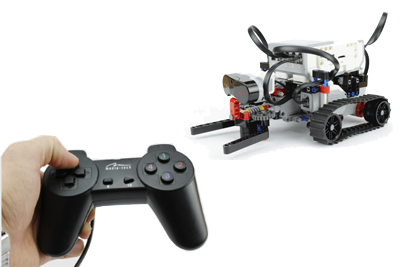Robot control
Learn to control your robot! Start by driving it from your keyboard or gamepad, and go all the way to creating a PC controlled robot that can follow a series of steps written in code.

What Will I Learn?
- Learn to control a robot from the keyboard.
- Learn to control a robot from the gamepad
- Learn to write preprogrammed robot procedures.
- Learn to use sensor input in robot control.
- Learn to use robot states in robot control.
- Learn to give feedback to the user based on conditions and states.
- Learn to do sensor calibration.
- Learn to use the IR remote controller for robot control.
Video
Start this courseCurriculum For This Course
Requirements
- This course is designed to suit users of either the EV3 home edition or the EV3 education edition.
- Users are required to have a Windows 10 PC with Bluetooth. (Most Windows 10 laptops have built in Bluetooth support)
- Users will need to download Ozeki 10 from www.ozeki.hu
- Users will need to know the basics of Ozeki 10 and Lego robots. Read more information in this course.
Description
Robots can be controlled with Ozeki 10. Since it recognizes your motors, sensors, etc. automatically you just have to use them. Ozeki 10 has a built-in application called SNAP to make simple programs. Lego robots can be easily programmed by using SNAP. You have to connect your EV3 Brick to Ozeki 10 to use SNAP.
This course is designed to get you started with programming your robot using SNAP. It shows you how to create simple programs without writing any code. At first you will control a cursor on the display to learn the basics. Later you will learn how to give instructions to the robot to control it like the cursor. You can control them from keyboard and gamepad. Then you will use sensors (mostly IR distance sensor) to control the robot. The last lecture teaches you how to follow a line with the robot using a color sensor.
The lectures in the course provide easy to follow step-by-step instructions and quiz questions. Enjoy the course!
Who is the target audience?
This course is designed for learners who are interested in learning SNAP basics and programming the Lego robots.

 Sign in
Sign in